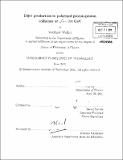| dc.contributor.advisor | Bernd Surrow. | en_US |
| dc.contributor.author | Walker, Matthew (Matthew Hsing Hung) | en_US |
| dc.contributor.other | Massachusetts Institute of Technology. Dept. of Physics. | en_US |
| dc.date.accessioned | 2012-01-30T16:57:03Z | |
| dc.date.available | 2012-01-30T16:57:03Z | |
| dc.date.copyright | 2011 | en_US |
| dc.date.issued | 2011 | en_US |
| dc.identifier.uri | http://hdl.handle.net/1721.1/68880 | |
| dc.description | Thesis (Ph. D.)--Massachusetts Institute of Technology, Dept. of Physics, 2011. | en_US |
| dc.description | In title on title page, "the square root of sigma" appears as the mathematical symbol, and "sigma" appears as the lower-case Greek letter. Cataloged from PDF version of thesis. | en_US |
| dc.description | Includes bibliographical references (p. 165-169). | en_US |
| dc.description.abstract | Polarized deep inelastic scattering (DIS) experiments indicate that quarks only carry approximately 30% of the proton spin, which led to interest in measuring the contributions of other components. Through polarized proton-proton collisions at the Relativistic Heavy Ion Collider (RHIC), the world's only polarized proton collider, it is possible to make an extraction of the polarized gluon distribution function [delta]g(x). This function describes the contribution of the gluon polarization to the proton spin. This thesis presents a measurement of the p + p ---> Jet + Jet + X (dijet) cross section from the 2005 RHIC running period and a measurement of the longitudinal double spin asymmetry ALL from the 2009 RHIC running period, both made using the Solenoidal Tracker at RHIC (STAR). The cross section is measured over the invariant mass range 20 < M < 116 GeV/c 2 with systematic uncertainties between 20 and 50%, driven by the jet energy scale uncertainty. The asymmetry is measured over the invariant mass range 20 < M < 80 GeV/c 2 in three different detector acceptances. The asymmetry measurement is compared to several theory scenarios in each of the detector acceptances, which allows extraction of the shape of the polarized gluon distribution function [delta]g(x). The results are consistent with a small, but positive, total gluon polarization. | en_US |
| dc.description.statementofresponsibility | by Matthew Walker. | en_US |
| dc.format.extent | 169 p. | en_US |
| dc.language.iso | eng | en_US |
| dc.publisher | Massachusetts Institute of Technology | en_US |
| dc.rights | M.I.T. theses are protected by
copyright. They may be viewed from this source for any purpose, but
reproduction or distribution in any format is prohibited without written
permission. See provided URL for inquiries about permission. | en_US |
| dc.rights.uri | http://dspace.mit.edu/handle/1721.1/7582 | en_US |
| dc.subject | Physics. | en_US |
| dc.title | Dijet production in polarized proton-proton collisions at [the square root of sigma] = 200 GeV | en_US |
| dc.type | Thesis | en_US |
| dc.description.degree | Ph.D. | en_US |
| dc.contributor.department | Massachusetts Institute of Technology. Department of Physics | |
| dc.identifier.oclc | 773355888 | en_US |
